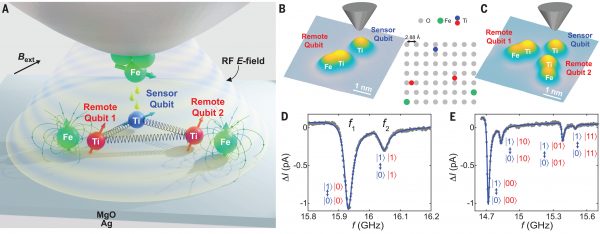Quantum architecture at the atomic scale: a leap forward in multi-qubit control
The quest for atomic-scale quantum coherence has seen a breakthrough with the realization of a multi-qubit platform. This innovation marks a pivotal advance in quantum computing, potentially reshaping the landscape of nanotechnology and quantum science.
Recent advancements in quantum technology have led to the creation of an atomic-scale platform capable of the coherent manipulation of multiple electron-spin qubits. This milestone, reported by Wang and colleagues in Science (2023), epitomizes the strides made in quantum science, establishing new paradigms in quantum computing and nanotechnology.
At the crux of this research is the ingenious assembly and control of electron-spin qubits at the atomic level. Achieving such precision has historically posed significant challenges due to the complexities inherent in atomic-scale operations. However, this study heralds an era of precision quantum engineering, manipulating quantum states with unprecedented control.
The platform’s unique feature lies in its ability to influence qubits situated beyond the immediate vicinity of the tunnel junction. This capability is enabled by adjoining single-atom magnets that produce local magnetic field gradients, thus augmenting the electron spins. To facilitate the readout of these “remote” qubits, the team employs a sensor qubit within the tunnel junction, executing pulsed double electron spin resonance with finesse.
This approach facilitates rapid and all-electrical operations on single, dual, and triple-qubit systems, a feat that accentuates the potential for advanced quantum functionalities. Through atom-by-atom construction on a surface, the research team has paved the way for sophisticated quantum computation, sensing, and simulation applications.
The implications of such a platform are multifaceted:
- Quantum Computing Advancement: This framework signifies a substantial leap toward scalable quantum computing.
- Precise Quantum Operations: The methodology allows for fine-tuned quantum maneuvers, enhancing computational accuracy.
- Multi-Qubit Entanglement: The ability to execute swift multi-qubit operations invites prospects for intricate quantum entanglement demonstrations at the Angstrom scale.
- Versatile Quantum Systems: The electron-spin based design permits exploration of various spin species and two-dimensional assemblies for computation and simulation.
- Decoherence Mitigation: The platform introduces innovative strategies to mitigate decoherence, thereby extending energy relaxation and coherence times.
In essence, the study by Wang et al. sets a new standard for quantum control, potentially catalyzing advancements in both quantum science and nanotechnology. This atomic-scale qubit platform not only redefines current quantum computational paradigms but also emboldens the future of quantum applications, promising an era of heightened precision and efficiency.

Figure: Bottom-up construction of multiple coupled electron spin qubits.
(A) Schematic: A sensor spin qubit (Ti, blue) is placed under the apex of a spin-polarized STM tip for readout. Remote qubits are constructed at precise separations to the sensor qubit by atom manipulation. Each remote qubit is composed of a spin-1/2 Ti atom (red) and a single-atom magnet (Fe) (green), where Fe’s magnetic field gradient, in combination with the RF electric field between the tip and the sample, coherently drives remote qubits. (B and C) Constant-current STM images showing atom-by-atom construction of a multi-qubit structure composed of two (B) and three (C) qubits (image size: 5.0 × 5.0 nm). Inset: atomic registry of the structure in (C). Structure in (B) has the same configuration but without remote qubit 2. (D and E) Continuous-wave ESR spectra measured with the tip positioned on the sensor qubit in the two-qubit (D) and three-qubit (E) structure. The quantum states of the sensor qubit are labeled by the first kets. Each ESR transition of the sensor qubit distinguishes a quantum state of the remote qubits (the second kets). The measured spin-polarized tunnel-current signal ΔI is the difference between averaged signals in lock-in A and B subcycles (fig. S10), which reflects the change of the sensor
spin polarization due to applied coherent control pulses [see section 4 of (19)]. Imaging conditions in (B) and (C): sample bias voltage VDC = 100 mV, time-averaged tunnel current IDC = 10 pA. ESR conditions in (D) and (E): VDC = 50 mV, IDC = 20 pA, zero-to-peak RF voltage VRF = 30 mV. The sample was kept at 0.4 K during measurements.



